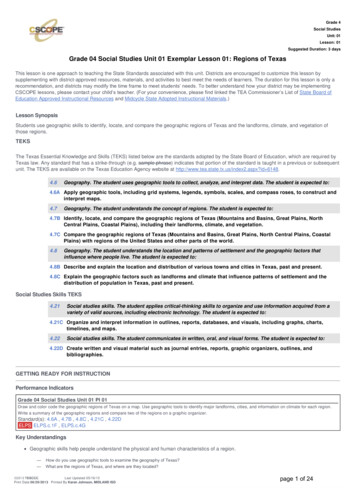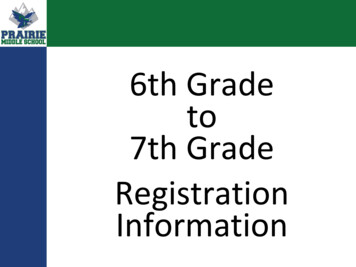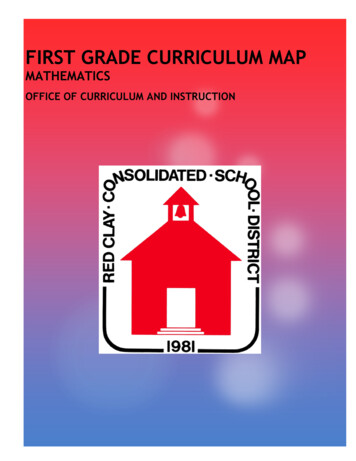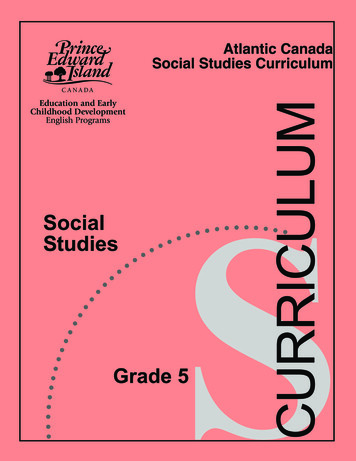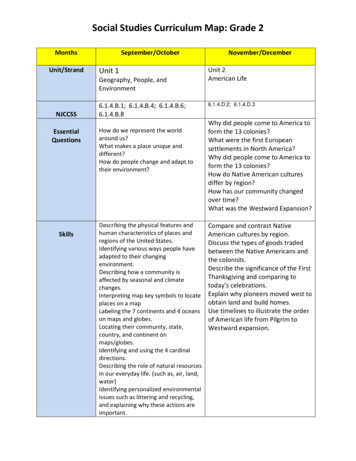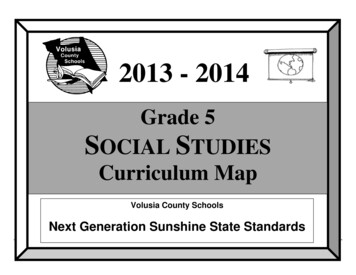
Transcription
2013 - 2014Grade 5SOCIAL STUDIESCurriculum MapVolusia County SchoolsNext Generation Sunshine State Standards1Volusia County Schools/Elementary CurriculumSpring 2013
Next Generation Sunshine State StandardsFifth Grade: United States History – The fifth grade Social Studies curriculum consists of the following content area strands: American History,Geography, Economics, and Civics. Fifth grade students will study the development of our nation with emphasis on the people, places and events up toapproximately 1850. Students will be exposed to the historical, geographic, political, economic, and sociological events which influenced the initialinhabitation, exploration, colonization, and early national periods of American History. So that students can see clearly the relationship between causeand effect in history, students should also have the opportunity to understand how individuals and events of this period influenced later events in thedevelopment of our nation.Fifth Grade OverviewAmerican HistoryStandard 1: Historical Inquiry and AnalysisStandard 3: Exploration and Settlement of North AmericaStandard 5: American Revolution & Birth of a New NationStandard 2: Pre-Columbian North AmericaStandard 4: Colonization of North AmericaStandard 6: Growth and Westward ExpansionGeographyStandard 1: The World in Spatial TermsEconomicsStandard 1: Beginning EconomicsStandard 2: Places and RegionsStandard 3: Environment and SocietyStandard 4: Uses of GeographyCivics and GovernmentStandard 1: Foundations of Government, Law, and the American Political SystemStandard 2: Civic and Political ParticipationStandard 3: Structure and Functions of Government2Volusia County Schools/Elementary CurriculumSpring 2013
Making ConnectionsCommon Core State StandardsLanguage Arts- Common Core State Standards for K–5 literacy in history/social studies, science, and technical subjects are integrated into the K–5Reading, Writing, Speaking and Listening, and Language LACC.5.L.3.4LACC.5.L.3.53Quote accurately from a text when explaining what the text says explicitly and when drawing inferencesfrom the text.Determine the meaning of general academic and domain-specific words and phrases in a text relevant to agrade 5 topic or subject area.Compare and contrast the overall structure (e.g., chronology, comparison, cause/effect, problem/solution) ofevents, ideas, concepts, or information in two or more texts.Draw on information from multiple print or digital sources, demonstrating the ability to locate an answer to aquestion quickly or to solve a problem efficiently.By the end of the year, read and comprehend informational texts, including history/social studies, science,and technical texts, at the high end of the grades 4–5 text complexity band independently and proficiently.Write opinion pieces on topics or texts, supporting a point of view with reasons and information.Write informative/explanatory texts to examine a topic and convey ideas and information clearly.With some guidance and support from adults, use technology, including the Internet, to produce andpublish writing as well as to interact and collaborate with others; demonstrate sufficient command ofkeyboarding skills to type a minimum of two pages in a single sitting.Conduct short research projects that use several sources to build knowledge through investigation ofdifferent aspects of a topic.Recall relevant information from experiences or gather relevant information from print and digital sources;summarize or paraphrase information in notes and finished work, and provide a list of sources.Draw evidence from literary or informational texts to support analysis, reflection, and research.Engage effectively in a range of collaborative discussions (one-on-one, in groups, and teacher-led) withdiverse partners on grade 5 topics and texts, building on others’ ideas and expressing their own clearly.Summarize a written text read aloud or information presented in diverse media and formats, includingvisually, quantitatively, and orally.Report on a topic or text or present an opinion, sequencing ideas logically and using appropriate facts andrelevant, descriptive details to support main ideas or themes; speak clearly at an understandable pace.Include multimedia components (e.g., graphics, sound) and visual displays in presentations whenappropriate to enhance the development of main ideas or themes.Determine or clarify the meaning of unknown and multiple-meaning words and phrases based on grade 5reading and content, choosing flexibly from a range of strategies.Demonstrate understanding of figurative language, word relationships, and nuances in word meanings.Volusia County Schools/Elementary CurriculumSpring 2013
COGNITIVE COMPLEXITY: Low, Moderate, HighWhat Does It Mean?The benchmarks in the Next Generation Sunshine State Standards (NGSSS) identify knowledge and skills students are expected to acquire at eachgrade level, with the underlying expectation that students also demonstrate critical thinking.The categories—low complexity, moderate complexity, high complexity—form an ordered description of the demands a test item may make on astudent. Instruction in the classroom should match, at a minimum, the complexity level of the learning target in the curriculum map.Low ComplexityLow-complexity items may require students to recalland recognize previously learned concepts, facts,and principles. Items typically require a single step orsimple demonstration of social studies skills andabilities. Items in this category do not necessarilyrequire the student to apply previously learnedinformation in a new scenario or context. Skillsrequired to respond to low-complexity items mayinclude, but are not limited to, the following: define the correct meanings of socialstudies-related words, concepts, andterminologyidentify or recall common contemporary orhistorical events, actions, personalities, orconceptsutilize a chart, table diagram, graph, orimage to recall or recognize informationidentify characteristics of a group, place, oreventModerate ComplexityModerate-complexity items involve greater flexibilityof thought and choice among alternatives than lowcomplexity items. Items require a response that goesbeyond the habitual, is not specified, and ordinarilyhas more than a single step or thought process. Thestudent is expected to apply previously learnedmaterial in new ways—using informal methods ofreasoning and problem-solving strategies—and tobring together skills and knowledge from variousdomains. Skills required to respond to moderatecomplexity items may include, but are not limited to,the following: 4apply or infer cause-and-effect relationshipsidentify outcomes of particular cause-andeffect relationshipsidentify the significance of historical orcontemporary events, actions, personalities,or conceptscategorize historical or contemporarypeople, places, events, or conceptsdetermine the relationship betweenhistorical or contemporary events, actions,personalities, or conceptsexplain historical or contemporary problems,patterns, or issuesHigh ComplexityHigh-complexity items make heavy demands onstudent thinking. Students must engage in moreabstract reasoning, planning, analysis, judgment,and creative thought. The items often involvemultiple steps and require the student to think in anabstract, sophisticated way. Skills required torespond to high-complexity items may include, butare not limited to, the following: solve or predict the outcome of a problemgeneralize or draw conclusions whenpresented with historical or contemporaryinformationprovide justification for events, actions, orissues in the past or current timeframepredict a long-term result, outcome, orchange within societyanalyze how changes have influencedpeople or social institutionsrecognize and explain historical orcontemporary misconceptionsanalyze similarities and differences betweenhistorical or contemporary eventsVolusia County Schools/Elementary CurriculumSpring 2013
HOW TO INTERPRET THESOCIAL STUDIES CURRICULUM MAPThe Social Studies Curriculum Map has been developed by teachers for teachers for ease of use during instructionalplanning. Definitions for the framework of the curriculum map components are defined below.Organizing Principle: the overarching organizational structure used to group content and concepts within the curriculum mapPacing: the recommended time frames within the year determined by teacher committee for initial delivery of instructionTopics: a grouping of standards and skills that form a subset of concepts covered in each unit of studyBenchmarks/Learning Targets: the content knowledge, processes, and enabling skills that will ensure successful mastery of thestandardsStandards: the Next Generation Sunshine State Standards required in the course descriptions posted on CPALMS by FLDOEAcademic Language: the content vocabulary and other academic language and phrases that support mastery of thebenchmarks/learning targets; for teacher and student use alikeResource Alignment: a listing of available, high quality and appropriate materials, strategies, lessons, textbooks, videos and othermedia sources that are aligned with the benchmarks/learning targets*The American History standards are repeated within each unit throughout the year5Volusia County Schools/Elementary CurriculumSpring 2013
ORGANIZING PRINCIPLES – 5TH GRADE U.S. AND FL HISTORY1: During the 1800’s the West became a magnet for people seeking adventure, religious freedoms, and economic opportunities. (Chpts 16 & 17)2: The idea of reform-the drive to improve society and the lives of Americans by addressing social issues-grew between 1820 and 1850. (Chapter 18)3: The Civil War was caused by historic economic, social, political, sectional differences that were further emotionalized by the issue of slavery.(Chapters 19 & 20)4: From 1861-1865, the Union and the Confederacy fought a brutal war pitting brother against brother. (Chapter 21) COW CALVALRY5: After the Civil War, reconstruction effectively determined the nature of the Union, the economic direction of the United States, and political control of the country. (Chapter22)6: During the late 19th Century, Native Americans’ ways of life were adversely affected as the Western United States settled. (Chapter 23) DEPARTING FOR DESTINY andRETURN TO BIG CYPRESS7: During the time period known as the “Gilded Age” (1870’s until early 1900’s) a booming industry fueled by immigration led to the growth of cities and friction betweenworkers and factory owners. (Chapter 24 & 25) WHERE PEACEFUL WATERS FLOW8: The Progressive movement partially succeeded in improving life for average Americans by curbing big business, making government more responsive to the will of the peopleand enacting social welfare legislation. (Chapter 26)9: From the 1890’s to 1918, the United States became increasingly active and aggressive in world affairs. (Chapter 27)10: The stark contrast from the Roaring twenties to the Great Depression led to the expectation of government intervention to maintain the economic stability of the nation throughthe “New Deal.” (Chapter 28) A DEADLY BOND, ORANGE FRITTERS AND A STORY, and SEMINOLE STEER11: The world’s triumph over fascism during WWII led to America’s emergence as a super power. (Chapter 29) U-12312: The Cold War led the U.S. to pursue ambivalent policy of confrontation, negotiation, and preventative maintenance between 1945-1970.(Chapter 30)13: Between 1954-1973, a campaign for equal rights for all Americans gained momentum with civil disobedience and other forms of protest. (Chapter 31)14: Since the 1950’s, the U.S. has faced triumph and tragedy, political transformation, clashes in a changing culture, changes in foreign and domestic affairs, economic policy, andtechnological innovations. (Chapter 32)6Volusia County Schools/Elementary CurriculumSpring 2013
ORGANIZING PRINCIPLE 1: During the 1800’s the West became a magnet forESTIMATED # OF WEEKS:people seeking adventure, religious freedoms and economic opportunities.ConceptsWestward aptationIrrigationCommunity propertyCulturesRevolutionAngloMexicanoWagon trainAdobeSpanish .2.2.1SS.B.2.2.2SS.B.2.2.3SS.B.2.2.4Essential Questions1. What were the reasons some Americans moved Westduring the 1800s? (explorers, Californios, mountain men,missionaries, pioneer women, Mormons, forty-niners, andChinese)2. What hardships were faced by western explorers andsettlers?3. Why did pioneers want to travel and move across theAppalachian Mountains?4. What was the purpose of ‘missions’ in California?5. How did Mexican rule change life in California?6. What type of transportation did settlers use to move west?7. How did settlers’ westward movement affect relationsbetween settlers and Native Americans?8. What legacies were left by the explorers, Californios,mountain men, missionaries, pioneer women, Mormons,forty-niners, and Chinese?SS.D.1.2.1SS.D.1.2.2SS.D.2.2.1SS.D.2.2.41. What are the nine important contributions from theMexicanos to the culture of the southwest?2. What did Anglo settlers in the southwest use and adaptfrom the Mexicano contributions? How do thesecontributions continue into the present day?August - SeptemberSkillsWrite a journal entryfrom the perspectiveof a person whomoved westward.People, Places, EventsMeriwether LouisWilliam ClarkSacagaweaNez Perce IndiansShoshoneFiestaOregon TrailManuel LisaMarcus and Narcissa WhitmanHenry and Eliza SpaldingHugh GlassJim BeckwourthCrowsPawneeSierra-NevadaBrigham YoungJoseph SmithSalt Lake CityJames MarshallTex-MexConestoga wagonChurch of Jesus Christ of theLatter-Day SaintsSluiceSutter’s MillChina TownQueuesSan FranciscoCorridoFlandangoLa BambaJotaJarabe tapatio (Mexican HatDance)Cinco de MayoUse an organizationaltool to enumerate thecauses and effects ofWestwardMovement.In small groups,create a symbol,statute or tribute toone of the majorgroups of Westernsettlers.Create a video thatdepicts daily life inthe Southwest as itpertains to Mexicanocontributions.Create a building thatdemonstrates Spanishstyle architecturetypical of the period.7PACING:4Volusia County Schools/Elementary CurriculumSpring 2013
ACTIVITIES (Teaching Resources)ASSESSMENTHoughton-Mifflin Teaching Resources:-Passport to FCAT Success Book-2-sided Desk MapHistory Alive-Interactive Student Notebook 1, Processing 16 and 17- Assessment 16 and 17Florida Heritage Education Program:-Colonial Pensacola 1781-1821-Farm Life in the Early 1800sHistory Alive: Project Ideas:-Movie Story Board: You have been asked to make aHistory Alive Teaching Resources: (Chapter 16 and 17)-Graphic Organizer Placard 16 and 17-Transparencies 16A - 16I, and 17-Student Handout 16-Placards 17A-17I-Map Transparencies 16-Student Handout 16-masking tape-CD Track 7, “Sweet Betsy from Pike”-Interactive Student Notebook 1, Preview 16 and 17-Interactive Student Notebook 1, Reading Notes for Chapter 16 and 17film about a group described in Chapter 16.You need to create a storyboard for the film.-make a list of characters (at least 3 historical) anddecide who you would like to play the different roles.-describe the setting, plot, action, climax, conclusion-Plan a Fiesta: Include the type of entertainment, music,dancing, food, and decorations. Describe and illustrateeach area of your essons/lessons.htmJohn James Audubon8Volusia County Schools/Elementary CurriculumSpring 2013
ORGANIZING PRINCIPLE 2: The idea of reform (the drive to improve society andESTIMATED # OF WEEKS:the lives of Americans by addressing social issues) grew between 1820-1850.ConceptsReformEraGreat AwakeningPlightAbolitionAbolitionist MovementDebateEqualitySuffrageTemperanceWomen’s .4.2.5SS.B.2.2.2SS.B.2.2.3Essential Questions1. How did religious and philosophical ideas inspire reformmovements?2. What were the important reform movements of the mid19th century?3. What was the role of women in the reform movements?4. Why did educational reformers believe that all citizensshould go to D.2.2.41. How did some Americans work to eliminate slavery?2. Why did many Americans fear the end of slavery?3. What actions did slaves take to resist slavery?1. How are the anti-slavery and Women’s Rights Movementrelated?2. What progress did women make toward equality during the1800’s?3PACING:September - OctoberSkillsWrite an article forThe Liberator or TheNorth Star.Create a protest signfor a Women’sSuffrage picket line.Develop a chant tomatch the message.Read the Declarationof Sentiments andcontrast it with theDeclaration ofIndependence.Write a short Negrospiritual that mighthave been sung by aslave.Write and present thespeech given byElizabeth Blackwellupon her graduationfrom medical school.People, Places, EventsDorothea DixSojourner TruthHenry David ThoreauWagon trainHorace MannPublic schoolPuritansPrudence CrandallAntioch CollegeFrederick DouglassThe LiberatorWilliam Lloyd GarrisonThe North StarQuakersAngelina GrimkeLucretia MottElizabeth Cady StantonLucy StoneElizabeth BlackwellSeneca Falls, New YorkDeclaration of SentimentsSusan B. AnthonyCharlotte WoodwardCompose a letter tothe editor of the localnewspaper regardingthe conditions of thelocal asylum.9Volusia County Schools/Elementary CurriculumSpring 2013
ACTIVITIES (Teaching Resources)ASSESSMENTHoughton-Mifflin Teaching Resources:-Passport to FCAT Success Book-2-sided Desk MapHistory Alive Teaching Resources: (Chapter 18)-Graphic Organizer Placard 18-Transparencies 18-Student Handout 18-Student Information 18-CD Track 8, “Let Us All Speak Our Minds”-Interactive Student Notebook 1, Preview 18-Interactive Student Notebook 1, Reading Notes for Chapter 18-Interactive Student Notebook 1, Activity Notes for Chapter sons.htmAfrican-Americans Settle in Fort MoseFernandina and Amelia IslandThomas Alva EdisonHenry Morrison FlaglerDr. John GorrieHarriet Beecher StoweHistory Alive-Interactive Student Notebook 1, Processing 18- Assessment 18History Alive: Project Ideas-Put students into cooperative groups and have each group crate aposter size graphic organizer that illustrates, in color, one of the reformmovements:Temperance, education, abolition, women’s rights,care for the mentally ill and mwww.popclock.netwww.nationalatlas.govTravel ChannelDiscovery Channel10Volusia County Schools/Elementary CurriculumSpring 2013
ORGANIZING PRINCIPLE 3: The Civil War was caused by historic economic, social,ESTIMATED # OF WEEKS:political and sectional differences that were further emotionalized by the issue of judiceSlave breakingResistance/defianceRebellionBondageForced laborSlave holderQuilting beeOppressionLegendFolktaleFugitive slaveSlave auctionRepublican PartyLincoln-Douglas debateSecessionCivil D.2.2.1Essential Questions1. How was a slave’s daily life different from that of his/herowner in terms of living conditions, religious life andcommunity experiences?2. How did economic and social forces contribute to thesurvival and growth of slavery in the United States for nearly250 years?1. How do you explain the following pre-war quote byPresident Lincoln? “Well, boys, your troubles are over.Mine have just begun.”2. How did the main areas of disagreement increase thetensions between the North and South prior to the Civil War?3. How was the debate over slavery related to the admissionof new states?4. What formal compromises were made in an attempt toaddress growing tensions?5. Why did the Fugitive Slave Act in Kansas-Nebraska Actmake the division between North and South worse?6. Why was the Republican Party formed?7. How did the Dred Scott decision, the Lincoln-Douglasdebates and John Brown’s raid affect Americans in the Northand South?8. How did the election of 1860 lead to the break-up of thenation?9. Why did secession lead to the Civil War?10. Why was Fort Sumter chosen as a target by theSoutherners?11. What role did Florida play during the Civil War?12. Why was support for slavery stronger in middle Floridathan in east or west Florida?3PACING:OctoberSkillsRole play theLincoln-Douglasdebate.Create a timeline ofevents leading to theCivil War.Create maps or othervisuals delineatingthe states consideredslave states/freestates as well as thoseadded by the variouscompromises.Use a Venn diagramor otherorganizational tool todepict the strengthsand weaknesses ofthe North and theSouth.Create a story quiltdepicting the life of aslave or slave family.People, Places, EventsW.E.B. DuBoisHarriet PowersFrederick DouglassNCCP (National Council ofColored People)Quilting beeEdward CoveyNat TurnerCongo SquareBrier RabbitShulo the HareUncle Tom’s CabinHarriet Beecher StoweAbraham LincolnStephen A. DouglasJohn BrownRoger TaneyDred Scott decisionLawrence, KansasElection of 1860Fort SumterFugitiveFugitive Slave ActKansas-Nebraska ActCivil WarCharles SumnerPreston BrooksAndrew P. ButlerCharleston, South CarolinaHarper’s FerryHarriet TubmanVolusia County Schools/Elementary CurriculumSpring 2013
ACTIVITIES (Teaching Resources)Houghton-Mifflin Teaching Resources:-Passport to FCAT Success Book-2-sided Desk MapFlorida Heritage Education Program:-African American Suffrage in FloridaHistory Alive Teaching Resources: (Chapters 19 and 20)-Graphic Organizer Placard 19 and 20-Transparencies 19, 20A-20E-Student Handout 19A and 19B-Student Information 18-Placards 19A-19H-Map Transparency 19, 20a-20c-CD Track 9, “Moses”-CD Tracks 10-21-Interactive Student Notebook 1, Preview 19 and 20-Interactive Student Notebook 1, Reading Notes for Chapter 19 and 20ASSESSMENTHistory Alive- Assessment 19 and 20History Alive: Project Ideas-Put students into cooperative groups and have each group crate aposter size graphic organizer that illustrates, in color, one of the reformmovements:Temperance, education, abolition, women’s rights,care for the mentally ill and handicapped-Design a class quilt and assemble it in the same way as a quiltingbee was held during these times. Each square should represent theindividual who creates laswww.popclock.netTravel ChannelDiscovery Channel12Volusia County Schools/Elementary CurriculumSpring 2013
ORGANIZING PRINCIPLE 4: From 1861 until 1865, the Union and the ConfederacyESTIMATED # OF WEEKS:fought a brutal war pitting brother against brother.ConceptsUnionConfederacyBlockadeBorder statesConstitutional RightsUnderground railroadHabeas .D.1.2.1SS.D.1.2.2SS.D.1.2.4SS.D.2.2.1Essential Questions1. What were the war strategies of the Union andConfederacy, and was the Confederacy successful at thebeginning of the war?2. What were the key battles and major turning points of thewar? What were the two key battles in Florida?3. Why did the war that many believed would be short-livedlast 4 years?4. How did physical geography (land and water) affect theoutcome of the Civil War?5. What problems did the soldiers face during the war otherthan the battles themselves? What problems did civiliansface?6. What expanded powers were given to President Lincolnduring the war? How did citizens respond to this?7. What role did Ulysses S. Grant and Robert E. Lee playduring the war?1. How did women and African Americans participate in thewar effort?2. How did the Union blockade affect the Confederacy?3. What was the significance of the surrender at AppomattoxCourthouse?4. Why did Lincoln issue the Emancipation Proclamation?5. What constitutional rights were affirmed as a result of theCivil War?6. How were the faces of the North and South changed afterthe war was over?4PACING:October - NovemberSkillsWrite anEmancipationProclamation forfreedom from choresand an early bedtime.(or other studentissues)Create and analyze apictograph, bar graphand/or line graphwith keys depictingdeath tolls for boththe North and Southduring the Civil War.Compare theprinciples in theGettysburg Addressto those in theDeclaration ofIndependence andPreamble to theConstitution.Analyze the lyrics ofthe song, DrinkingGourd.People, Places, EventsMerrimacMonitorUlysses S. GrantRobert E. LeeAppomattox CourthouseUnionConfederacyAbraham LincolnJefferson DavisBattle of Bull RunBattle of RichmondBattle of AntietamBattle of GettysburgBattle of VicksburgBattle of OlusteeBattle of Natural BridgeEmancipation ProclamationGettysburg AddressGeneral Winfield ScottRose GreenhowClara BartonGeorge McClellanAtlanta, GeorgiaGeneral George MeadeGeneral George PickettAdmiral FarragutColonel Robert Gould ShawMassachusetts 54 RegimentRole play thesurrender atAppomattoxCourthouse.13Volusia County Schools/Elementary CurriculumSpring 2013
ACTIVITIES (Teaching Resources)Houghton-Mifflin Teaching Resources:-Passport to FCAT Success Book-2-sided Desk MapPink and Say by Patricia PalaccoFollow the Drinking GourdLegendary Florida: Cow CalvalryFlorida Heritage Education Program:-The Maple Leaf: A Civil WarHistory Alive Teaching Resources: (Chapter 21)-Graphic Organizer Placard 21-Student Handout 21A and 21B-Student Information 21A-21F-Placards 21A-21D-Map Transparency 21-CD Track 22, “The Bonnie Blue Flag”-CD Track 23, “Tenting Tonight”-CD Track 24, “Civil War Siege Sounds”-CD Track 25, “Slavery Chain Done Broke at Last”-envelopes, letter size-masking tape, 8 rolls-scratch paper, cut into 24 strips, 4” x 11”-Interactive Student Notebook 1, Preview 19 and 20-Interactive Student Notebook 1, Reading Notes for Chapter 19 and20ASSESSMENTHistory Alive-Interactive Student Notebook 1, Processing 21- Assessment 21History Alive: Project Ideas:-Essay: First defend, and then criticize, the idea thatgovernment should be given more power in wartimethan peacetime.-Role Play: Write a two page conversation betweena Southerner and a Northerner who meet on a train inthe mid-1800s. Have them talk about the differencesbetween their lives. Present to the class.-Political Cartoon: Draw a political cartoon thatillustrates Lincoln’s statement “A house dividedagainst itself cannot stand”.-Debate: Give the Pros and Cons on the institution ofslavery from both the North’s and South’s ssons/lessons.htmFlorida’s Role in the Civil War: “Supplier of the Confederacy”Florida’s Famous atlas14Volusia County Schools/Elementary CurriculumSpring 2013
ORGANIZING PRINCIPLE 5: After the Civil War, Reconstruction effectivelyESTIMATED # OF WEEKS:determined the nature of the union, the economic direction of the United States andpolitical control of the mentFreedmen’s BureauBlack CodesJim Crow LawsCash regationReconciliationCivil sential Questions1. What was John Wilkes Booth’s motivation forassassinating President Lincoln and how did the assassinationaffect southern reconstruction?2. How did plans for reconstruction differ between the Northand the South?3. What was the purpose of the Freedmen’s Bureau?4. What were the three main purposes of the Black Codes?5. How did the 13th Amendment differ from theEmancipation Proclamation?6. What groups participated in Reconstruction in the south?7. How did the Republican Party dominate Southern politicsduring Reconstruction?8. What changes happened in the South during the later yearsof Reconstruction?9. How the Democratic Party begin to regain control ofSouthern politics at the end of Reconstruction?10. How did the lives of African Americans improve afterReconstruction?11. Why were towns like Eatonville, Florida, important forAfrican Americans?12. How did Florida’s government change duringReconstruction?13. What were Jim Crow laws, and how did they work tolimit the rights of African Americans?2PACING:DecemberWrite a eulogy forPresident AbrahamLincoln’s funeral.Compare and contrastthe amendments ofthe U.S. Constitutionto those of theFlorida Constitution.Analyze politicalcartoons relating toReconstruction.Evaluate the successof Reconstruction.People, Places, EventsFord’s TheaterJohn Wilkes BoothCarpetbaggersScalawagsShare croppersFreedmen’s BureauBooker T. WashingtonAndrew Johnson13th Amendment14th Amendment15th AmendmentForty Acres and a MuleKu Klux KlanGrandfather ClauseLiteracy TestsPoll TaxPlessy vs. FergusonRutherford B. HayesCompromise of 1877Thomas NastJosiah Thomas WallsVolusia County Schools/Elementary CurriculumSpring 2013
ACTIVITIES (Teaching Resources)ASSESSMENTHoughton-Mifflin Teaching Resources:-Passport to FCAT Success Book-2-sided Desk MapHistory Alive Teaching Resources: (Chapter 22)-Graphic Organizer Placard 22-Transparency 22-masking tape-Interactive Student Notebook 1, Preview 22-Interactive Student
Fifth Grade: United States History – The fifth grade Social Studies curriculum consists of the following content area strands: American History, Geography, Economics, and Civics. Fifth grade students will study the development of our nation with emphasis o
